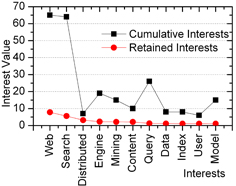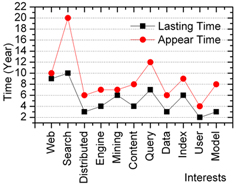E-foaf:interest Vocabulary Specification 0.1
From The International WIC Institute WIKI
Contents |
Versions
Version 0.2 has been moved to http://http://wiki.larkc.eu/e-foaf:interest
This version (Starting from Jan 17th, 2010)
https://www.wici-lab.org/wici/wiki/index.php?title=E-foaf:interest_Vocabulary_Specification_0.1
Latest version
http://http://wiki.larkc.eu/e-foaf:interest
Previous version
https://www.wici-lab.org/wici/wiki/index.php?title=E-foaf:interest_Vocabulary_Specification_0.1
Authors
- Yi Zeng (International WIC Institute, Beijing University of Technology),
- Yan Wang (International WIC Institute, Beijing University of Technology),
- Zhisheng Huang (Vrije University Amsterdam, the Netherlands),
- Danica Damljanovic (University of Sheffield, the United Kingdom)
Copyright
Copyright © 2010 Yi Zeng (WICI), Yan Wang (WICI), Zhisheng Huang (VUA), Danica Damljanovic (USFD)
This work is part of the effort by the EU FP-7 Large Knowledge Collider Project. This work is licensed under a Creative Commons Attribution 3.0 License. This copyright applies to the e-foaf:interest Vocabulary Specification and related documentation in RDF. The vocabularies are extended based on FOAF Vocabulary Specification.
Main Content
Abstract
The e-foaf:interest Vocabulary is aimed at extending the FOAF vocabulary on user interests evaluated from different perspectives. It focuses on extending "foaf:interest" by providing more detailed vocabularies related to user interests.
Status of this Document
The development of the core methods for the interest value acquisition began from October 2008, the first version of "e-foaf:interest Vocabulary Specification" was released at January 20th, 2010.
The e-foaf:interest Vocabulary List
The e-foaf:interest vocabulary has 3 versions, namely: "e-foaf:interest Basic", "e-foaf:interest Complement", and "e-foaf:interest Complete". They are composed of a set of class vocabulary and a set of property vocabulary.
e-foaf:interest Basic
- e-foaf:interest (class)
- e-foaf:interest_value (property)
- e-foaf:interest_value_updatetime (property)
- e-foaf:interest_appeared_in (property)
- e-foaf:interest_appear_time (property)
- e-foaf:interest_has_synonym (Property)
- e-foaf:interest_co-occur_with (Property)
e-foaf:interest Complement
- e-foaf:cumulative_interest_value (Property)
- e-foaf:retained_interest_value (Property)
- e-foaf:interest_lasting_time_interval (Property)
- e-foaf:interest_appear_time_interval (Property)
e-foaf:interest Complete
is the union of the set of vocabularies from "e-foaf:interest Basic" and "e-foaf:interest Complement".
Definitions of the Vocabularies
Following lines are needed for the definition of each vocabulary listed below: ...
<!ENTITY e-foaf "https://www.wici-lab.org/wici/e-foaf-interest/e-foaf.owl#" > <!ENTITY owl "http://www.w3.org/2002/07/owl#" > <!ENTITY xsd "http://www.w3.org/2001/XMLSchema#" > <!ENTITY rdf "http://www.w3.org/1999/02/22-rdf-syntax-ns#" > <!ENTITY foaf "http://xmlns.com/foaf/spec/20100101.rdf#" >
....
xmlns:e-foaf = "https://www.wici-lab.org/wici/e-foaf-interest/e-foaf.owl#" xmlns:owl = "http://www.w3.org/2002/07/owl#" xmlns:rdf = "http://www.w3.org/1999/02/22-rdf-syntax-ns#" xmlns:rdfs = "http://www.w3.org/2000/01/rdf-schema#" xmlns:xsd = "http://www.w3.org/2001/XMLSchema#"> xmlns:foaf = "http://xmlns.com/foaf/spec/20100101.rdf#">
....
Here we give some details on the definition of each vocabulary.
- e-foaf:interest (Class)
Status: unstable
Definition:
e-foaf:interest is a class that is used to represent the agent's interest.
<owl:Class rdf:ID="e-foaf:interest"> <rdfs:subClassOf rdf:resource="&owl;Thing"/> </owl:Class>
Properties Included: e-foaf:interest_value, e-foaf:interest_vaule_updatetime, e-foaf:interest_appeared_in, e-foaf:interest_appear_time, e-foaf:interest_has_synonym, e-foaf:interest_co-occur_with.
- e-foaf:interest_value (Property)
Status: unstable
Definition:
"e-foaf:interest_value" represents the value of an interest. The value of a specified interest is a real number. If the Agent is interested in an interest, the interest value is greater than zero (namely a positive number), if not, the interest value is smaller than zero (namely a negative number).
<owl:DatatypeProperty rdf:ID="e-foaf:interest_value">
<rdfs:domain rdf:resource="#e-foaf:interest" />
<rdfs:range rdf:resource="&xsd;number" />
</owl:DatatypeProperty>
Note: This property is supposed to be oriented to interest values from any perspective if the user do not care much about the types of interest values (Some possible perspectives to evaluate interests values are defined in "e-foaf:interest Complement", namely, the perspective of "cumulative interest value", "retained interest value", "interest lasting time", "interest appear time", etc.). It can also be a user defined value.
- e-foaf:interest_value_updatetime (Property)
Status: unstable
Definition:
"e-foaf:interest_value_updatetime" represents the update time of the specified interest value. It may be the time that user specifies the interest value, or the time that an algorithm updates the value.
<owl:DatatypeProperty rdf:ID="e-foaf:interest_value_updatetime">
<rdfs:domain rdf:resource="#e-foaf:interest" />
<rdfs:range rdf:resource="&xsd;dateTime" />
</owl:DatatypeProperty>
- e-foaf:interest_appeared_in (Property)
Status: unstable
Definition:
"e-foaf:interest_appeared_in" represents where the interest appeared in.
<owl:DatatypeProperty rdf:ID="e-foaf:interest_appeared_in">
<rdfs:domain rdf:resource="#e-foaf:interest" />
<rdfs:range rdf:resource="foaf:Document" />
</owl:DatatypeProperty>
Note:
The motivation of this property is to help to keep the original resources where the interests come from and be reused for calculation of interest value when needed. The design of this property is inspired by "from" in Attention Profiling Markup Language [APML 2009].
- e-foaf:interest_appear_time (Property)
Status: unstable
Definition:
"e-foaf:interest_appear_time" is the time when the interest appears in a certain kind of scenario.
<owl:DatatypeProperty rdf:ID="e-foaf:interest_appear_time">
<rdfs:domain rdf:resource="&foaf;Document" />
<rdfs:range rdf:resource="&xsd;dateTime" />
</owl:DatatypeProperty>
- e-foaf:interest_has_synonym (Property)
Status: unstable
Definition:
"e-foaf:interest_has_synonym" represents that the subject and the object of this predicate are synonyms and are semantically very relevant.
<owl:ObjectProperty rdf:ID="e-foaf:interest_has_synonym"> <rdfs:domain rdf:resource="#e-foaf:interest" /> <rdfs:range rdf:resource="#e-foaf:interest" /> </owl:ObjectProperty>
Note:
In some use cases, synonyms need to be merged together or marked as semantically very related and this property is very useful in these senarios.
- e-foaf:interest_co-occur_with (Property)
Status: unstable
Definition:
"e-foaf:interest_co-occur_with" represents that the subject and the object of this predicate co-occur with each other in some cases.
<owl:ObjectProperty rdf:ID="e-foaf:interest_co-occur_with"> <rdfs:domain rdf:resource="#e-foaf:interest" /> <rdfs:range rdf:resource="#e-foaf:interest" /> </owl:ObjectProperty>
Note:
If the interests co-occur with each other, it indicates that the user is interested in having these two interests together.
- e-foaf:cumulative_interest_value (Property)
Status: unstable
Definition:
"e-foaf:cumulative_interest_value" is a sub property of "e-foaf:interest_value" representing the cumulative appear times of an interest in a certain time interval.
<owl:DatatypeProperty rdf:ID="e-foaf:cumulative_interest_value">
<rdfs:subPropertyOf rdf:resource="#e-foaf:interest_value" />
<rdfs:domain rdf:resource="#e-foaf:interest" />
<rdfs:range rdf:resource="&xsd;number" />
</owl:DatatypeProperty>
- e-foaf:retained_interest_value (Property)
Status: unstable
Definition:
"e-foaf:retained_interest_value" represents the retained interest value of an interest in a specific time.
<owl:DatatypeProperty rdf:ID="e-foaf:retained_interest_value">
<rdfs:subPropertyOf rdf:resource="#e-foaf:interest_value" />
<rdfs:domain rdf:resource="#e-foaf:interest" />
<rdfs:range rdf:resource="&xsd;number" />
</owl:DatatypeProperty>
Note: The retained interest value can be calculated based on the interest retention function proposed in [Zeng 2009].
- e-foaf:interest_lasting_time_interval (Property)
Status: unstable
Definition:
"e-foaf:interest_lasting_time_interval" is used to represent, until a specified time, the longest value of the time intervals between the specified interest appears and disappears for the first time.
<owl:DatatypeProperty rdf:ID="e-foaf:lasting_time_interval">
<rdfs:domain rdf:resource="#e-foaf:interest" />
<rdfs:range rdf:resource="&xsd;duration" />
</owl:DatatypeProperty>
- e-foaf:interest_appear_time_interval (Property)
Status: unstable
Definition:
"e-foaf:interest_appear_time_interval" is used to represent, the appear time interval value in a specific time, it represents the cumulative value of the lasting time intervals.
<owl:DatatypeProperty rdf:ID="e-foaf:appear_time_interval">
<rdfs:domain rdf:resource="#e-foaf:interest" />
<rdfs:range rdf:resource="&xsd;duration" />
</owl:DatatypeProperty>
We should emphasize that each corresponding interest value is calculated based on a specific function, and the update time might not be consistent. Hence, each interest value (including cumulative interest and retained interest) has a specific update time.
Examples Using the e-foaf:interest Vocabularies
Use Case 1: Scientific Research Interests Description
Research interest is a specific kind of user interest which can be quantitatively studied. Take Information Retrieval Scientist Ricardo baeza Yates as an example, following figures show a partial example of the cumulative interests values, retained interests values, interests lasting time and interests appear time of the author from an analysis of his publication list from DBLP (within the time interval 1987-2009).


A partial example of the description is as follows:
<?xml version="1.0" encoding="ISO-8859-1"?>
<!DOCTYPE owl [
<!ENTITY ricardo-research-interests "https://www.wici-lab.org/wici/e-foaf-interest/ricardo-research-interests.owl#" >
<!ENTITY owl "http://www.w3.org/2002/07/owl#" >
<!ENTITY xsd "http://www.w3.org/2001/XMLSchema#" >
<!ENTITY rdf "http://www.w3.org/1999/02/22-rdf-syntax-ns#" >
<!ENTITY foaf "http://xmlns.com/foaf/spec/20100101.rdf#" >
<!ENTITY dc "http://purl.org/dc/elements/1.1/" >
<!ENTITY e-foaf "https://www.wici-lab.org/wici/e-foaf/e-foaf.owl#" >
]>
<rdf:RDF
xmlns = "https://www.wici-lab.org/wici/e-foaf-interest/ricardo-research-interests.owl#"
xml:base = "https://www.wici-lab.org/wici/e-foaf-interest/ricardo-research-interests.owl#"
xmlns:dc = "http://purl.org/dc/elements/1.1/"
xmlns:owl = "http://www.w3.org/2002/07/owl#"
xmlns:rdf = "http://www.w3.org/1999/02/22-rdf-syntax-ns#"
xmlns:rdfs = "http://www.w3.org/2000/01/rdf-schema#"
xmlns:xsd = "http://www.w3.org/2001/XMLSchema#"
xmlns:foaf = "http://xmlns.com/foaf/spec/20100101.rdf#"
xmlns:e-foaf = "https://www.wici-lab.org/wici/e-foaf/e-foaf.owl#">
<foaf:Person rdf:about="http://www.informatik.uni-trier.de/~ley/db/indices/a-tree/b/Baeza=Yates:Ricardo_A=">
<foaf:name>Ricardo Baeza-Yates</foaf:name>
<e-foaf:interest>
<rdf:Description rdf:about="https://www.wici-lab.org/wici/wiki/index.php/Web">
<dc:title>Web</dc:title>
<e-foaf:interest_appeared_in>
<rdf:Description rdf:about="http://dblp.uni-trier.de/rec/bibtex/conf/cikm/AlonsoGB09">
<e-foaf:interest_appear_time rdf:datatype="&xsd;dateTime">2009-11-15T05:30:00+08:00</e-foaf:interest_appear_time>
</rdf:Description>
</e-foaf:interest_appeared_in>
<e-foaf:interest_co-occur_with>
<rdf:Description rdf:about="https://www.wici-lab.org/wici/wiki/index.php/Search">
<dc:title>Search</dc:title>
<e-foaf:interest_hasSynonym>
<rdf:Description rdf:about="https://www.wici-lab.org/wici/wiki/index.php/Retrieval">
<dc:title>Retrieval</dc:title>
</rdf:Description>
</e-foaf:interest_hasSynonym>
</rdf:Description>
</e-foaf:interest_co-occur_with>
<e-foaf:cumulative_interest_value rdf:parseType="Resource">
<rdf:value rdf:datatype="&xsd;number">65</rdf:value>
<e-foaf:interest_value_updatetime rdf:datatype="&xsd;dateTime">2009-12-22T23:30:00+08:00</e-foaf:interest_value_updatetime>
</e-foaf:cumulative_interest_value>
<e-foaf:retained_interest_value rdf:parseType="Resource">
<rdf:value rdf:datatype="&xsd;number">7.81</rdf:value>
<e-foaf:interest_value_updatetime rdf:datatype="&xsd;dateTime">2010-01-17T13:30:00+08:00</e-foaf:interest_value_updatetime>
</e-foaf:retained_interest_value>
<e-foaf:interest_lasting_time_interval rdf:parseType="Resource">
<rdf:value rdf:datatype="&xsd;duration">P9Y</rdf:value>
<e-foaf:interest_value_updatetime rdf:datatype="&xsd;dateTime">2010-01-17T05:30:00+08:00</e-foaf:interest_value_updatetime>
</e-foaf:interest_lasting_time_interval>
<e-foaf:interest_appear_time_interval rdf:parseType="Resource">
<rdf:value rdf:datatype="&xsd;duration">P10Y</rdf:value>
<e-foaf:interest_value_updatetime rdf:datatype="&xsd;dateTime">2010-01-10T03:15:00+08:00</e-foaf:interest_value_updatetime>
</e-foaf:interest_appear_time_interval>
</rdf:Description>
</e-foaf:interest>
</foaf:Person>
</rdf:RDF>
Following SPARQL query is aimed at acquiring the users' interest names, co-occurred interests, synonyms, retained interest values, and their update time, as well as interest lasting time intervals and their update time from the upper file which includes these interests related information.
PREFIX rdf: <http://www.w3.org/1999/02/22-rdf-syntax-ns#>
PREFIX rdfs: <http://www.w3.org/2000/01/rdf-schema#>
PREFIX opus: <http://lsdis.cs.uga.edu/projects/semdis/opus#>
PREFIX foaf: <http://xmlns.com/foaf/0.1/>
PREFIX e-foaf: <https://www.wici-lab.org/wici/e-foaf-interest/e-foaf.owl#>
PREFIX dc: <http://purl.org/dc/elements/1.1/>
PREFIX time-entry: <http://www.isi.edu/~hobbs/damltime/time-entry.owl#>
SELECT *
WHERE
{
?person e-foaf:interest ?interestId1 .
?interestId1 dc:title ?interest_title1 .
?interestId1 e-foaf:interest_appeared_in ?source1 .
?source1 e-foaf:interest_appear_time ?appear_time .
?interestId1 e-foaf:interest_co-occur_with ?interestId2 .
?interestId2 dc:title ?interest_title2 .
?interestId2 e-foaf:interest_hasSynonym ?interestId3 .
?interestId3 dc:title ?interest_title3 .
?interestId1 e-foaf:retained_interest_value ?y1 .
?y1 rdf:value ?retained_value .
?y1 e-foaf:interest_value_updatetime ?updatetime1 .
?interestId1 e-foaf:interest_lasting_time_interval ?y2 .
?y2 rdf:value ?lasting_value .
?y2 e-foaf:interest_value_updatetime ?updatetime2 .
}
The interest profile is used as contextual information when the specific user (in this use case: Ricardo Baeza-Yates) query on a scientific literature system (e.g. CiteSeerX, DBLP), more refined results can be acquired when adding user preference as implicit constraints to the original (vague) query [Zeng 2009]. A partial example of the interest refined query can be found at: http://wiki.larkc.eu/csri-rdf .
Reference
- [Zeng 2009] Yi Zeng, Yiyu Yao, Ning Zhong. DBLP-SSE: A DBLP Search Support Engine Proceedings of the 2009 IEEE/WIC/ACM International Conference on Web Intelligence, IEEE Press, 2009.
- [APML 2009] The Attention Profilling Markup Language Specification. http://www.apml.areyoupayingattention.com
- [WI 2009] Weighted Interest Vocabulary, Namespace Document 24 December 2009 - first draft, http://eculture.cs.vu.nl/git/notube/notube.git?a=blob_plain;f=ontologies/specgen/vocabularies/weighted-interests/spec
